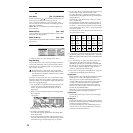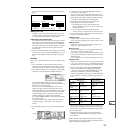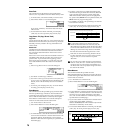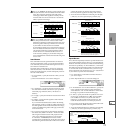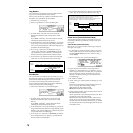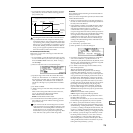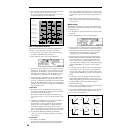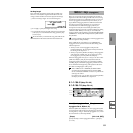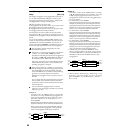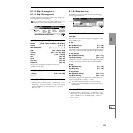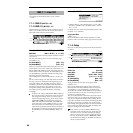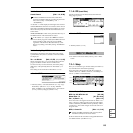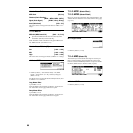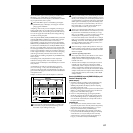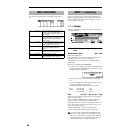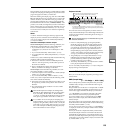
82
6.1–1(2)b: Assign
Assign [Off, A, B]
This assigns arpeggiator A or arpeggiator B to each track 1–
8, 9–16. When the [ARP ON/OFF] key is turned on, the
arpeggiator specified for each track will run, subject to the
“Arpeggiator Run” settings and setting here.
Off: The arpeggiator will not operate.
A: Arpeggiator A will operate. Use the Arp. A page to select
the arpeggio pattern and set the parameters.
B: Arpeggiator B will operate. Use the Arp. B page to select
the arpeggio pattern and set the parameters.
For tracks that you wish to realtime-record, select either
arpeggiator A or B. If you specify an arpeggiator for two or
more tracks, the arpeggiator will play each of the tracks you
specify.
You can set A and B to two different MIDI channels, and
control one from the keyboard and the other from an exter-
nal MIDI device connected to MIDI IN. You can also use
multi-track recording (MultiREC) to simultaneously record
the note data that is generated from the two arpeggiators.
The arpeggiator cannot be triggered by the notes
played by the sequencer.
If the tracks 1–16 assigned to arpeggiators A and B have
a “Status” (3.1–1(2)a) of INT or BTH, they will be
played by the note data generated by the arpeggiator. If
the “Status” is BTH, EXT, or EX2, MIDI note data will
be transmitted on the “MIDI Channel” of each track.
In this case, arpeggiator A or B will be triggered by the
“MIDI Channel” of any track 1–16 to which the corre-
sponding arpeggiator is assigned.
If the (“Local Control On” GLOBAL 2.1–1a) is turned
OFF, the arpeggiator will not be triggered by note data
from the keyboard. It will be triggered by note data
received at MIDI IN. If you wish to record just the trig-
ger notes on an external sequencer and run the
TRITON Le’s arpeggiator in this way, turn Local Con-
trol OFF.
If you want the note data generated by the arpeggiator
to be recorded on the external sequencer, turn Local
Control ON, and turn off the echo back function of the
external sequencer.
You can control the arpeggiator from an external
sequencer, or record arpeggio note data on an external
sequencer. (
☞p.237)
Example 1)
On tracks 1 and 2, set “MIDI Channel” (3.1–1(2)a) to 01
and “Status” (3.1–1(2)a) to INT. Assign arpeggiator A to
track 1 and arpeggiator B to track 2, and check “Arpeg-
giator Run A, B” (6.1–1a). In “Track Select” (1.1–1c)
choose Track01.
With the front panel [ARP ON/OFF] key OFF, play the
keyboard and tracks 1 and 2 will sound simultaneously.
When you turn on the front panel [ARP ON/OFF] key
and play the keyboard, arpeggiator A will operate for
track 1 and arpeggiator B will operate for track 2.
Example 2)
For tracks 1, 2 and 3, set the “MIDI Channel” (3.1–1(2)a)
to 01, 02, and 03 respectively, and set “Status” (3.1–1(2)a)
to INT. Assign arpeggiator A to tracks 1 and 2, and
arpeggiator B to track 3. Check the “Arpeggiator Run A,
B” (6.1–1a) setting.
• In “Track Select,” choose Track01.
Playing the keyboard when the front panel [ARP ON/
OFF] key is off will play the sound assigned to track 1.
Playing the keyboard when the front panel [ARP ON/
OFF] key is on will cause arpeggiator A to operate for
tracks 1 and 2, and produce sound for both tracks.
• In “Track Select,” choose Track02.
Playing the keyboard when the front panel [ARP ON/
OFF] key is off will play the sound assigned to track 2.
Playing the keyboard when the front panel [ARP ON/
OFF] key is on will cause arpeggiator A to operate for
tracks 1 and 2, and produce sound for both tracks.
• In “Track Select,” choose Track03.
Playing the keyboard when the front panel [ARP ON/
OFF] key is off will play the sound assigned to track 3.
Playing the keyboard when the front panel [ARP ON/
OFF] key is on will cause arpeggiator B to operate for
track 3, and play the sound assigned to track 3.
•Alternatively, you could choose Track01 in “Track
Select” to run arpeggiator A for tracks 1 and 2, and use
an external MIDI device connected to the TRITON Le’s
MIDI IN to send note data to MIDI channel 3 to play
arpeggiator B.
■ 6.1–1(2)c: UTILITY
☞“Memory Status,” “Rename Song,” “Delete Song,” “Copy
From Song,” “Copy From Combi” (1.1–1d), “Copy Arpeg-
giator” (COMBI 6.1–1c), “FF/REW Speed ,” “Set Loca-
tion” (1.1–1d)
Track2 MIDI Ch=1ch Status=INT
Arpeggiator
A
Arpeggiator
B
Arpeggiator
Assign
A
B
Pattern - A
Pattern - B
Pattern - A
Pattern - B
Trigger
= Ch1
Trigger
= Ch1
Track1 MIDI Ch=1ch Status=INT
Pattern - B
Pattern - A
Pattern - A
Track2 MIDI Ch=2ch Status=INT
Arpeggiator
A
Arpeggiator
B
Arpeggiator
Assign
A
A
Pattern - A
Pattern - B
Trigger
= Ch1, Ch2
Trigger
= Ch3
Track3 MIDI Ch=3ch Status=INTB
Track1 MIDI Ch=1ch Status=INT



